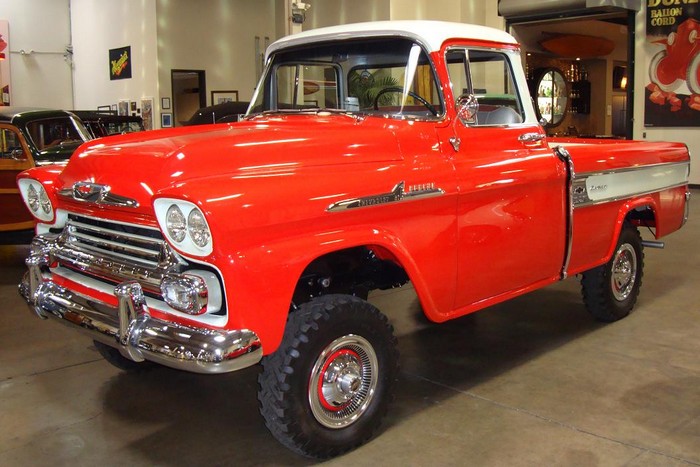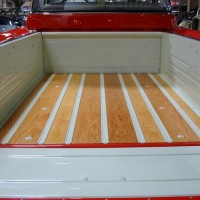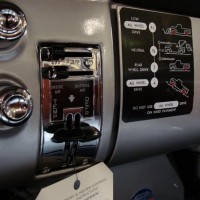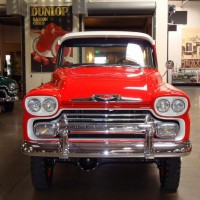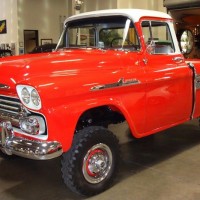SCM Analysis
Detailing
| Vehicle: | 1958 Chevrolet Cameo NAPCO 4x4 |
| Number Produced: | 1,405 (all 1958 Cameos) |
| Original List Price: | $2,273 (plus NAPCO Powr-Pak $1,248 option) |
| Tune Up Cost: | $200 |
| Chassis Number Location: | On plate attached to the rear face of left-hand door hinge pillar and on right side of cowl under hood |
| Engine Number Location: | Passenger's side forward of the cylinder head |
| Club Info: | www.napco4X4.org |
| Website: | http://www.facebook.com/NAPCO4x4 |
| Alternatives: | 1958 Chevrolet Cameo (without Powr-Pak), 1958 Chevrolet Apache, 1958 Dodge Sweptside |
This truck, Lot S650, sold for $67,100, including buyer’s premium, at the Russo and Steele auction on June 20–22 in Newport Beach, CA.
Throughout World War II, a thriving industrial parts supply firm by the name of Northwestern Auto Parts Company, aka NAPCO, was busy as a beaver knocking out parts for our boys in uniform fighting oversees. NAPCO was part of our industrialized military machine, and the company was instrumental in the production of specialized automotive parts and assemblies for military vehicles.
After World War II, and the evaporation of U.S. government contracts, NAPCO had to shift gears and find another way to keep the shop lights on. With that, the notion that they could design and build kit 4×4 drive systems seemed logical. After all, if they can build parts for tanks, they surely could build one hell of a 4×4 system. As it turns out, they did.
The Powr-Pak 4×4
The exact date of the very first NAPCO 4×4 Powr-Pak conversion kit is not well known, and it is a point of endless debate in various forums. That said, there is agreement that NAPCO reached an accord with GM in 1956 to supply the Powr-Pak conversion kits, so the nifty, easy-to-install system could be bolted up on the factory assembly line. GMC would be the first truck line to use the 1,410-pound kit. The system would be used until 1960, when GM changed the front axle design so that it was incompatible with the NAPCO system.
These NAPCO trucks would quickly earn the name “Mountain Goat” due to their ability to traverse rough terrain, which was something a factory-built American production truck did not do well. Actually, trucks off the line could barely slog through a muddy field.
That all changed with the NAPCO 4×4 system installed. Now ranchers, farmers, and sportsmen had a vehicle that could handle the task. NAPCO ads featuring the system proclaimed proudly that you could “now have a standard Chevrolet four-wheel-drive pickup featuring the traction power of a tank, or, at the flip of a finger, a smoother-riding, high-speed, over-the-road truck. Aptly named the Mountain Goat, this full-sized pickup will literally leap up mountains, as well as carry you through deep mud, sand, or snow.”
Initially, the system could be ordered only on a Chevrolet truck with the 235-ci, 6-cylinder engine, while GMC owners could have it installed on V8 configurations. If you were late to the party, a dealer could install the system and convert your formerly two-wheel-drive truck into a four-wheel-drive ground pounder.
NAPCO’s Powr-Pak system was not only easy for a dealer to install, but easy to service as well. Their two-speed 4×4 conversions were composed of 85% GM parts. That meant getting your off-road tank serviced at the local garage or dealer was not difficult.
An up-and-down market
Over the years, the truck market has been on a slow, tedious climb. For the most part, most collectors pretty much ignored them up until a sudden value boom started in 2009.
Sure, there would be the occasional penny-loafer truck guy who thought they were worth more — and would pay it — but for the most part, it simply wasn’t worth it to spend a yard of green fill (cash, that is) to restore a two-wheel-drive 1950s truck, let alone a field rat 4×4 NAPCO work truck.
Most trucks, especially a work-a-thon hardware hauler, rotted from the elements. Guys generally did not buy them to tote golf clubs around. These were trucks built for guys who wore rubber boots and overalls, and could work in a frozen field without even donning a pair of leather gloves. They were tough trucks, built for tough guys.
Gaining traction
That all seemed to change as shiny, over-restored, minty pickups started testing the waters. Super-nice trucks started to flow into the auctions and found remarkable money — by truck standards, at least. As the market grabbed hold and gained traction, more and more formerly gunshot trucks started to get pulled out of barns and fields as restorers hunted them down. The better the body, the more a guy would pay.
Eventually, too much supply and less demand took over, and that — coupled with the Great Recession — took some of the air out of the truck market. Recently, however, the truck market has once again sparked with collectors, and values have begun to climb for extremely nice restorations. Our subject truck is a shiny example of that.
An extraordinarily rare Cameo
Most NAPCO 4×4 systems are usually found on a more muscular truck, such as a Suburban or 3200 Series Apache. Conversions were done to transform a work truck into a better work truck, one that could haul parts, a load of fill or a bed full of manure across a muddy field. Our subject truck breaks that stereotype. Cameos were not trucks that usually found their ass-end hitched to a chain to pull out a tree stump.
Cameos were stylish and marketed to an elite crowd. Most of the vintage ads that I found pictured the truck with well-dressed gentlemen and their best gals overlooking pristine horse farms — not cow pastures. A gentleman’s truck for sure. This truck as equipped likely listed somewhere in the neighborhood of $3,521 back in 1958, which was not cheap. In comparison, a workaday strippy would have set you back about $1,600.
Our subject truck was reported to be in very fine 2 condition — and perhaps even knocking on 1 condition under the right lighting. There are not many comps in SCM’s Platinum Auction Database — and no comps for a Cameo with work clothes on.
A very nice Sunday-go-to-meetin’ Cameo will fetch about $45,000 to $55,000 at the right venue, and I’ve seen them knock on $100,000 when in jewel-like condition. It doesn’t surprise me to see the ultra-rare NAPCO Powr-Pak system add 50% to the value. There is one NAPCO in our Platinum Database, albeit for a Suburban (SCM# 40333), that sold for $75,600 at Barrett-Jackson’s 2006 Scottsdale auction.
There is no wonder that this gorgeous truck found such solid money. It’s just extremely rare — how rare is anybody’s guess. It includes known history from new and stands tall, not only off the ground but in presentation as well. This was a smart purchase for a finite example, and the new owner should be pleased. Given that, I would consider this 1958 Cameo to be well bought. ?
(Introductory description courtesy of Russo and Steele.)
